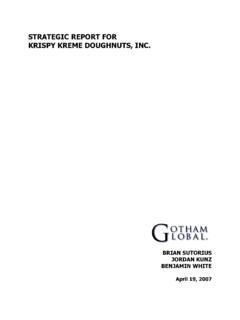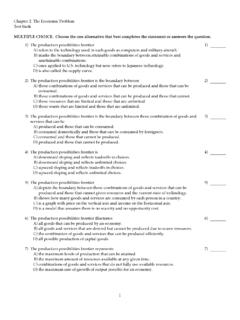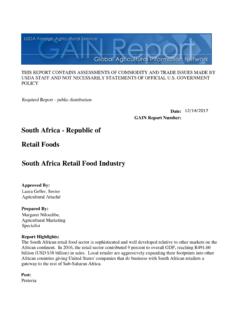Transcription of Inditex Strategy Report - Pomona
1 Inditex Strategy Report Jessica Vincent Phillip Kantor Daniel Geller April 19, 2013. Contents Executive Summary .. 3. Company Background .. 4. Business 5. Retail 6. Company Background .. 8. Financial Analysis .. 11. Profitability & Shareholder Returns .. 11. Revenues .. 11. Costs ..12. Liquidity & Stock Performance ..14. Competitive Analysis (Five Forces Framework) ..16. Market Internal 20. Supplier Power ..21. Buyer Power .. 22. Substitutes & Complements .. 23. SWOT Analysis .. 23. 23. Weaknesses .. 26. Opportunities .. 27. Threats .. 29. Strategic 32. Sources .. 43. 2. Executive Summary Industria de Dise o Textil , also known as The Inditex Group, is the world's leading and fastest growing fashion producer and retailer, headquartered in Arteixo, Spain. The Inditex Group is made up of more than 100 companies operating in textile design, manufacturing, and distribution, and is responsible for producing 840 million garments a year, with eight retail store formats: Bershka, Massimo Dutti, Oysho, Pull & Bear, Stradivarius, Uterq e, Zara, and Zara Home.
2 These retail formats collectively occupy 6,009 stores in 86 markets. Inditex faces competition from companies such as H&M and Benetton, but is set apart by its unique business model. Inditex controls the entire fashion process as well as retail. In the variable and fast changing fashion world, Inditex prioritizes time-to-market through vertical integration, making them the pioneer of fast fashion. Competitors traditionally prioritize production cost and outsource manufacturing to China. This Strategy is cheap but creates a long supply chain. Inditex , on the other hand, sources more than half of its products from Spain, Portugal and Morocco, creating a short, manageable, and more responsive supply chain. Despite the higher costs, in the fashion world the ability to react quickly is key. Other companies must predict trends, while Inditex can observe and respond.
3 Inditex 's computerized inventory system, state-of-the-art production and warehousing, and a short supply chain cut lead-time to 10-15 days between design and distribution, compared to the 5-6 month industry average. Zara, Inditex 's flagship retail format, generated 66% of the company's overall sales in 2012. Currently, Europe accounts for 66% of group sales, though sales in Spain accounting for 22% of revenue have stalled due to the poor economy, causing the company to aggressively seek new markets. Inditex has doubled its store count from 3,000 to 6,000 since 2007 as it expanded its store space by between 8% and 10% a year. Recently Inditex has opened more than a store a day, or about 500 stores a year. It is reported that this growth rate is to be maintained for the next three to five years, with an emphasis in Sales also benefited from a global rollout of online stores, starting with Zara Home in 2007 and each additional retail format in 2010.
4 Zara is the most prominent online concept currently receiving more than million unique visitors per Though Inditex has yet to provide more information about online sales, Credit Suisse estimates online purchases will generate over $ million by the end of 2013, almost doubling 2012 3. Inditex is an extremely healthy company with strong financials allowing continued self- funded expansion. Net sales for Inditex reached $ billion in fiscal 2012, an increase of 16%. from However, as competitors continue to mature and Inditex 's rapid expansion begins to pose new challenges due to varied global consumer demand and increased distribution needs, we recommend the following strategies that will allow Inditex to continue to grow, increase sales, and maintain its global market share and position: Continued Global Expansion: Inditex can sustain 6% to 9% growth for the next 10 years, and has ample opportunity to do so in Asia, Eastern Europe, and Latin America.
5 Wide-scale expansion into the American market would require Inditex to produce plus size clothing, which would complicate production processes and deviate from its brand image, and is not advisable at this time. As the company continues to expand outside of Europe, it will need to expand its business model based on proximity sourcing by developing logistics, design, and distribution centers in Asia and potentially the Americas as well. Continued Online Retail Expansion and Development: Online consumer purchases are predicted to increase drastically in the next several years, making online ecommerce presence imperative to Inditex 's continued success. Zara is the brand's most developed online store, but is still only available in 21 countries. Expanding and optimizing the websites and social media platforms of all retail formats will increase company sales, allow Inditex to draw customers without access to brick-and-mortar stores, and capture valuable consumer data with which to make future decisions.
6 It is also recommended that Inditex begin to leverage search engine optimization and search engine marketing techniques in order to gain new customers on the web. Expansion of Massimo Dutti: Buying trends and customer demands are highly volatile within the apparel retail industry. Inditex currently relies on Zara for two-thirds of overall sales, leaving it vulnerable if consumer trends shift away from fast fashion demand. Massimo Dutti is the group's most upscale retail format, offering a slightly differentiated value proposition than Inditex 's other fashion brands. By expanding the presence of the Massimo Dutti concept, Inditex will both strengthen its brand portfolio and hedge against changing consumer demand by capturing a greater percentage of the higher-end market. 4. Business Model Source: Own Creation via Morgan Stanley Inditex 's success is based upon its refined and fast supply chain responsible for providing its eight retail formats with a high turnover of fashionable clothing and accessories at affordable prices and in low quantities.
7 Through this process, Inditex avoids large inventory and risk, and promotes frequent buying. The fashion items found in most of Inditex 's retail formats are highly imitative of designer styles, which Inditex scouts on runways in Paris and Milan and in high-fashion catalogs. Inditex does not employ well-known designers but instead draws from a team of 300 to come up with products that mirror these trends in more affordable fabric, which it manufactures through a partially vertically integrated process that occurs largely in close proximity to headquarters. Franchising is not a part of Inditex 's overall corporate Strategy , and it is only utilized in markets with strict foreign regulations. The company currently owns 88% of its retail stores. Inditex is also unique in that it has no advertising budget.
8 While Gap, H&M, and the industry spend 5, 4, and percent of revenues on advertising respectively, Inditex only spends Instead, Inditex relies on prime storefronts in chic locations and lets this Strategy do the signaling to customers, supporting a high-end image despite their lower price point. Although Inditex typically leases its stores to maintain flexibility in possible future relocations, it owns more than 220 freeholds. Over the past year and a half, Inditex bought stores on 5th Avenue in New York for $325 million, on Corso Vittorio in Milan for $135. million, and on Oxford Street in London for $235 million. As of January 2012 the carrying value of the group's land and buildings was $1,458 million, though they have never been revalued and the market value is likely to be higher since most were acquired years 5.
9 R etail S ubsidiaries The Inditex corporate Strategy is to provide general back-office support to its retail concepts, and assist with international expansion and new concepts in existing markets. Each retail format capitalizes on the fast fashion model, while every concept is managed independently and has control over its own design, purchasing, and logistics. Each of Inditex 's eight retail brands targets a different customer demographic. This segmented marketing approach allows Inditex to capture a larger share of the consumer market, while each individual format can specialize. The store offerings and d cor of each brand vary, and are tailored to appeal to different age groups and styles. Source: Grupo Inditex Growth Opportunities Presentation Zara Zara is the foundation of Inditex 's success as well as their first retail format established in 1975.
10 This brand generates about two-thirds of group sales by offering highly imitative fashion trends at affordable prices. Zara's core consumers are 20-45 year old women, though they also have kids and menswear offerings. Zara is the group's most geographically diverse retail concept with 80% of its full line stores located outside of Rather than advertising, Zara relies on chic locations and light, airy, Prada inspired store layouts and shop-window Today, there are 1,721 Zara stores in 86 countries. Zara's online retail format launched in 2010, and is now available in 21. countries, covering most of Europe, Japan, China, and the United States, and will continue to be rolled out in smaller 6. Pull & Bear Inditex launched the Pull & Bear retail format in 1991, focusing on young urban fashion.










